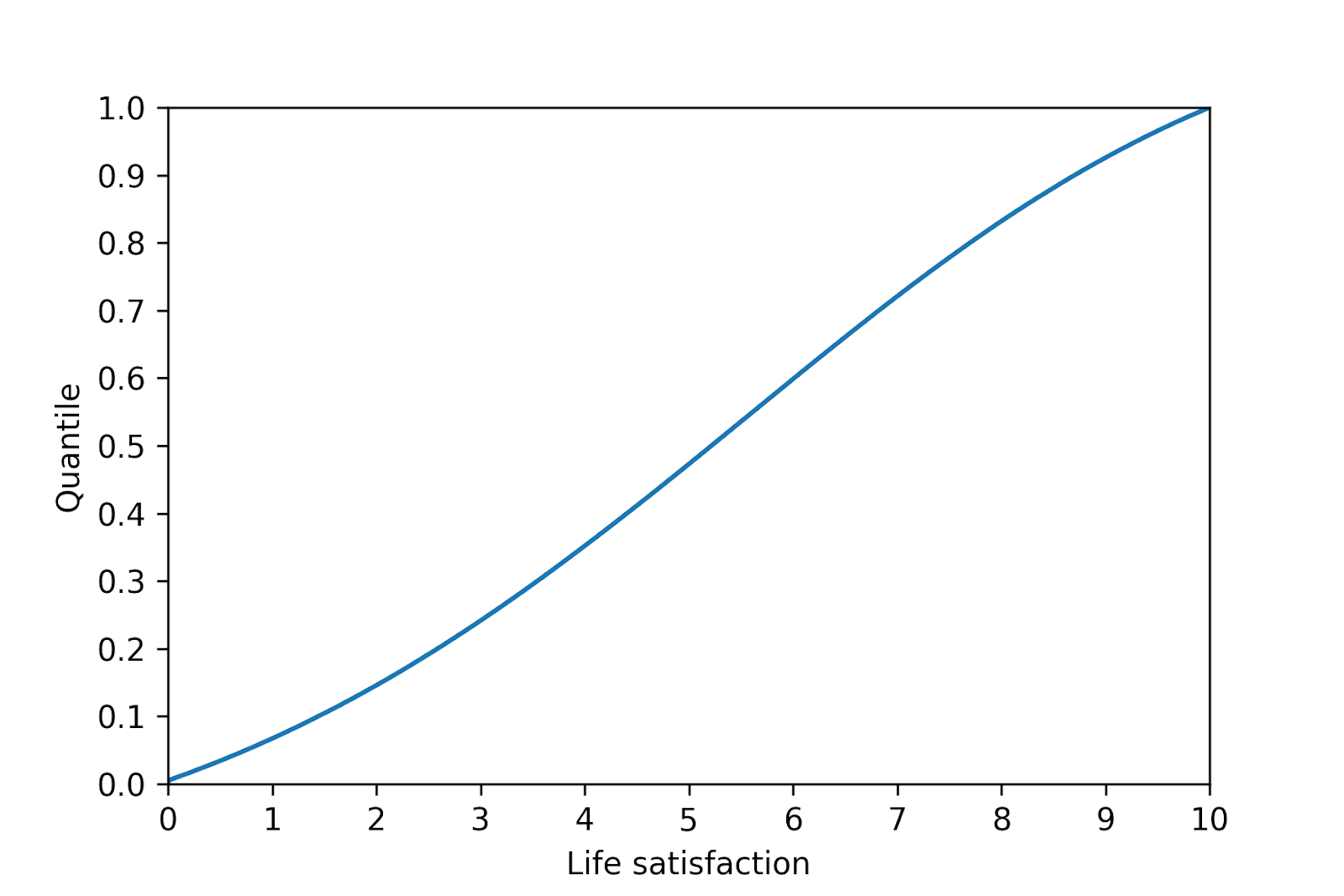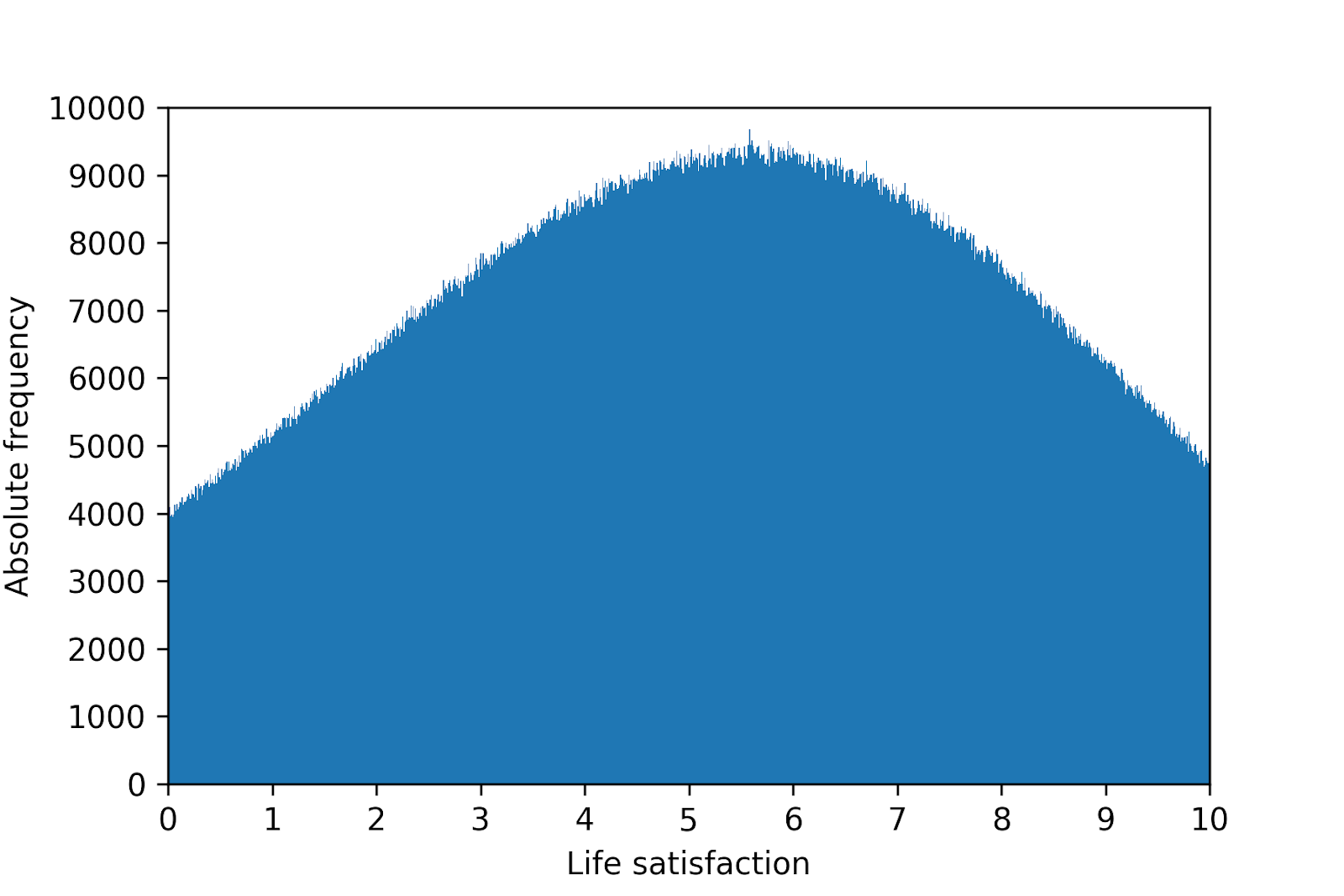Global life satisfaction distribution
By Vasco Grilo🔸 @ 2022-10-01T15:39 (+22)
Summary
- I estimated the global life satisfaction distribution in this Sheet and this Colab based on the mean and standard deviation of the life satisfaction distribution of 142 countries.
- For the neutral life satisfaction of 0.949 (on a scale from 0 to 10) I supposed, the distribution I obtained implies the fraction of people with negative lives is 6.37 %.
Methods
I determined the 2020 global life satisfaction distribution as assessed by the Cantril Ladder[1] generating samples from the life satisfaction distribution of 142 countries totalling 95.0 %[2] of the global population. To do this:
- I generated 1 sample for each 1 k people, and defined the population size based on data from OWID[3].
- I assumed truncated normal distributions with minimum and maximum equal to 0 and 10 for all countries, as these are the minimum and maximum possible values in the Cantril Ladder.
- For each country, I supposed the mean and standard deviation of the non-truncated distribution to be equal to the mean and standard deviation of the life satisfaction[4].
- I set the mean to the mean life satisfaction between 2019 and 2021 given in the 2022 World Happiness Report[5] (WHR).
- I calculated the standard deviation from the 95 % confidence interval (CI) and sample size of the life satisfaction[6].
- Of the 146 countries analysed in the WHR, 1 was excluded due to missing population data, and 3 due to lack of sample size data.
In addition, I estimated the fraction of people with negative lives[7] assuming a value for neutral life satisfaction. In reality, the neutral point varies from country to country (even from person to person), and is very uncertain. According to the section “How Many People Have Positive Wellbeing?” of Chapter 9 of What We Owe the Future (WWOF) from William MacAskill:
The relative nature of the scale means that it is difficult to interpret where the neutral point should be, and unfortunately, there have been only two small studies directly addressing this question. Respondents from Ghana and Kenya put the neutral point at 0.6, while one British study places it between 1 and 2.
Moreover, although I aggregated life satisfaction scores of different countries into the same global distribution, they need not be comparable. From the same section of WWOF:
Life satisfaction surveys mainly provide insights into relative levels of wellbeing across different people, countries, and demographics. They do not provide much guidance on people’s absolute level of wellbeing.
With these caveats, I supposed the neutral life satisfaction to be 0.949. I estimated this from the geometric mean between the neutral point for Ghana and Kenya of 0.6, and the mean of the lower and upper bound of the neutral point for the UK of 1.5 (= (1 + 2)/2).
Results
The calculations are in this Sheet and this Colab. The mean and standard deviation of the truncated and non-truncated distribution, minimum, deciles, maximum, cumulative distribution function, and histogram[8] of the 2020 global life satisfaction are presented below. For the supposed neutral life satisfaction of 0.949, the fraction of people with negative lives is 6.37 %.
| 2020 global life satisfaction | |||
|---|---|---|---|
| Truncated | Non-truncated[9] | ||
| Mean | Standard deviation | Mean | Standard deviation |
| 5.14 | 2.62 | 5.17 | 4.21 |
| Quantile | 2020 global life satisfaction |
|---|---|
| 0 (minimum) | 0 |
| 0.1 | 1.44 |
| 0.2 | 2.59 |
| 0.3 | 3.54 |
| 0.4 | 4.41 |
| 0.5 | 5.22 |
| 0.6 | 6.01 |
| 0.7 | 6.82 |
| 0.8 | 7.70 |
| 0.9 | 8.70 |
| 1 (maximum) | 10.0 |


Discussion
The fraction of people with negative lives of 6.37 % I estimated is of the same order of magnitude of Will’s best guess of 10 %[10], and also suggests most humans have positive lives. In addition, the estimate for the mean global life satisfaction of 5.14 being higher than that for the neutral life satisfaction of 0.949 hints the mean human life is positive.
For a more resilient conclusion, it would be important to consider at a global level other lines of evidence addressed in WWOF besides life satisfaction surveys:
- “Surveys that simply ask people if they are happy”.
- “Asking people at random times how they feel in that moment”.
- ^
From OWID, the question respecting the Cantril Ladder is as follows. “Please imagine a ladder, with steps numbered from 0 at the bottom to 10 at the top. The top of the ladder represents the best possible life for you and the bottom of the ladder represents the worst possible life for you. On which step of the ladder would you say you personally feel you stand at this time?”.
- ^
See B153 of tab “Life satisfaction parameters”.
- ^
Except for Kosovo, whose data were taken from The World Bank.
- ^
Note the mean and standard deviation of the non-truncated distributions are different from the mean and standard deviation of the truncated distributions (see here). I supposed them to be equal because I failed to determine the mean and standard deviation of the non-truncated distributions with scipy.optimise.fsolve for 76.1 % (= 108/142) of the analysed countries. Columns H and I of tab “Life satisfaction parameters” of this Sheet contain the values I managed to determine.
- ^
The respective data can be downloaded by clicking on “Data for Figure 2.1”.
- ^
“Standard deviation” = “length of the 95 % CI” * “mean sample size between 2019 and 2021”^0.5 / 0.95 / 2. Data for the 95 % CI can be downloaded by clicking on “Data for Figure 2.1”, and for the sample size is in Table 2 of the Statistical Appendix of the WHR.
- ^
A person would rather not be born than living a negative life, neglecting effects on other beings.
- ^
The bin length of the histogram is 0.01.
- ^
I determined the mean and standard deviation of the non-truncated distribution with scipy.optimise.fsolve.
- ^
From the aforementioned section of WWOF:
I [William MacAskill] would tentatively suggest that something like 10 percent of the global population have lives with below-neutral wellbeing.